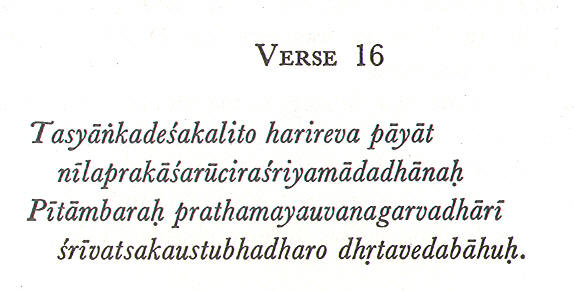
(Svadhisthana)
Tasyānkadeśakalito harireva pāyāt
nīlaprākasaruciraśriyādadhānaḥ
Pītāmbaraḥ prathamayauvanagarvadhārī
śrīvatsakaustubhadharo dhṛtavedabāhuḥ.
May Hari, who is within it1, who is in the pride of early youth, whose body is of luminous blue beautiful to behold, who is dressed in yellow raiment, is four armed and wears the Sri-vatsa2, and the Kaustubha3, protect us!
May Hari, who is within it1 = This verse tells that Vishnu is the Varuna-Bija. Vishnu is within the lap of the Bindu of VAm. Sri-vatsa2 = the favorite of Sri or Lakshmi. This is the auspicious curl of hair on the chest of Vishnu and His Avatara Krishna. It symbolizes Prakrti (the world of matter). Kaustubha3 = The gem worn by Vishnu symbolizes the souls that are united with the Kaustubha gem.
anka-deśa-kalita = Within it. In the Bindu above Varuna-Bija, in the same way as Brahma is in the lap of DharA-BijA (Earth Bija) in Muladhara Chakra. nīla-prākasa-rucira-śriyam = Blue effulgence lustrous splendor. He possesses the enchanting beauty of His blue effulgence. His luminous effulgent blue body (Vishnu) is beautiful to behold. śrīvatsakaustubha = (Vishnu wears) Srivatsa and Kaustubha gem. The gem shines like ten thousand gems; His VanamAla (garland of forest flowers) shines like ten thousand moons. The Srivatsa curl of hair on His right chest shines like ten thousand moons. All these are chanted in eulogizing Vishnu. Meditate on dark-blue Hari (Vishnu) wearing Pitambara (yellow garment) holds the Conch, Discus, Mace and Lotus in His four hands. VanamAla (garland of forest flowers = All-season Forest flower garland of many colors and hues comes down to the level of Vishnu's knees and has in it Kadamba flowers in the middle. The garland symbolizes the elements, Earth, Water, Fire. Air and Ether. prathama-yauvana-garvadhārī : Of prime youth, proud Vishnu.
Vishnu's weapons: Mace or Club symbolizes Mahat (Adi-Buddhi, Universal Intelligence, Divine Mind, Cosmic Intellect, Nous-Greek, Radiation from the Universal Absolute). the Conch: Sattvic Ahamkara. Virtuous self-illumined I-doer. Sattva = Virtue, illumination, enlightening Knowledge. Ahamkara = I-doer, the Universal Ego of Vishnu. The bow = symbolizes Tamasic Ahamkara meaning absorption of the universe. Tamas = darkness. The Sword: Divine Knowledge. Its Sheath: ignorance. Discus: the mind. the arrows: the senses.
In Muladhara, Brahma sits on his transport (Vahana) Hamsa and here Vishnu flies on Garuda ( a mythical bird appearing like an Eagle.
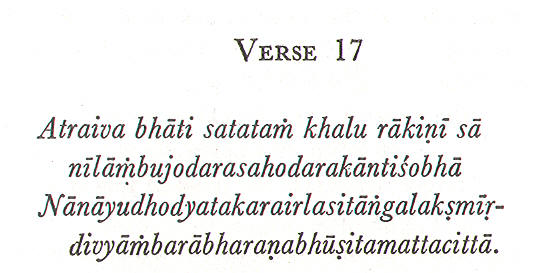 (Svadhisthana)
(Svadhisthana)
Atraiva bhāti satataṁ khalu rākiņī sā
nīlāṁbujodarsahodarakāntiśobhā
Nānāyudhodyatakarairlasitāṅgalakṣmīṛ-
divyāṁbarābharaņabhūṣitaattacittā
It is here that Rakini always dwells1. She is of the colour of a blue lotus. The beauty of Her body is enhanced by Her uplifted arms holding various weapons. She is dressed in celestial raiment and ornaments, and Her mind is exalted with the drinking of ambrosia.
Rakini always dwells1 = Rakini shines (bhāti) here in Svadhisthana Chakra.
nīlāṁbujodarsahodarakāntiśobhā = Her radiant beauty equals the interior of the blue lotus.
Rakini is the resident Devi of Svadhistana Chakra sitting on the double lotus with a streak of blood running from her nostrils. Meditate of blue-colored Rakini with red eyes and fierce teeth. She is the furious aspect and holds in Her hands a spear, a lotus, a drum, and a battle-axe. She grants wished-for boons and is fond of rice.

(Svadhisthana)
Svādhiṣṭhānākhyametatsarasijamamalaṁ cintayedyomanusya-
stasyāhaṁkāradoṣādiksakalarepuḥ kṣīyate tatkṣaņena
yogīśaḥsoऽpiṃohādbhutatimiracayebhānutulyaprakāśo
gadyaih padyaiḥ parabhandhairviracayati sudhāvākyasandoha lakṣmiḥ
He who meditates upon this stainless Lotus, which is named Svadisthana, is freed immediately from all his enemies, such as the fault of Aha kara and so forth. He becomes a Lord among Yogis, and is like the Sun illumining the dense darkness of ignorance. The wealth of his nectar-like words flows in prose and verse in well-reasoned discourse.
enemies = Enemies of six passions: KAma = Lust. Lobha = Greed. Moha = delusion. Mada = pride. MAtsaryya = envy. All these six enemies arise from Ahamkara, a sense of mineness. kara = Egoism.
The benefits from contemplation of Svadhisthana Lotus Chakra are described.
Ahaṁkāra-doṣādi: the Ahamkara fault and so forth. See above for the six evil predispositions. These six ennemies are destroyed by contemplating on Svadhisthana Lotus Chakra. The darkness of MAyA and MohA are destroyed.
Summary of Verses 14 to 18: Svadhisthana Lotus Chakra of vermilion color has six letters (Ba, Bha, Ma, Ya, Ra, La) of the color of lightning placed on the petals. In the pericarp of the Main Lotus there is a white region with second 8-petalled Lotus with half-moon in its center. Inside this region is the Varuna-Bija, VAM seated on Makara with a noose on hand. In the hollow of Bindu is Vishnu sitting on Garuda holding in His four hands the Conch, the Discus, the Mace, and the Lotus. Vishnu, of youth and pride, wears yellow raiment, a garland of forest flowers, the mark of Srivatsa on His chest and a gem Kaustubha on His breast. Fierce looking Sakti Rakini with three eyes, projecting fangs, and bleeding nostrils, sits in the pericarp of the red lotus, is of syAma varna, holds in her four hands SUla, Abja, Damaru, and Tanaka (a spear, a lotus, a drum, and a battleaxe) and is fond of white rice.
MANIPURA
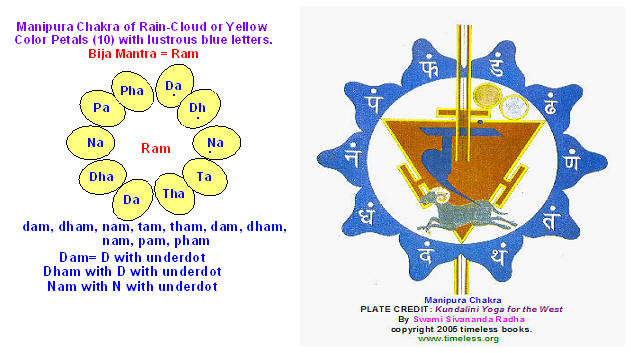


Tasyordhve nābhimūle daśadalalasite pūrṇameghaprakāśe
nīlāmbhojaprakāśairrupahitajaṭhare dādipāntaiḥ sacandraiḥ
Dhāyedvaisvānarauṇamihirasamaṁ maṇḍalam tat trikoṇaṁ
tadbāhye svastikāvyaistribhirabhilasitaṁ tatra vahneḥ svabījam.
Above it1, at the root of the navel, is the shining Lotus of ten petals2, of the colour of heavy-laden rain-clouds. Within it are the letters Da to Pha, of the colour of the blue lotus with the Nada and Bindu above them. Meditate there on the region of Fire, triangular in form and shining like the rising sun. Outside it are three Svastika marks3, and within, the Bija of Vahni himself4.
Above it1 = Above Svadhisthana Lotus Chakra. the shining Lotus of ten petals2 = The Manipura Chakra, the seat of the element of Fire, the sign of which is a triangle. three Svastika marks3 = It is an auspicious mark In the Indian context, the svastika stands for universal welfare. "Swasti" means well-being of one and all, "ka" means symbol. the Bija of Vahni himself4. = Ram is the seed Mantra of Fire. Vahini = Fire. 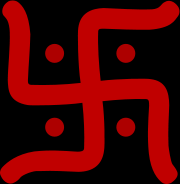
Svastika (Ansate Cross) is derived from the Sanskrit svastika (in Devanagari, स्वस्तिक), meaning any lucky or auspicious object, and in particular a mark made on persons and things to denote good luck. It is composed of su- (cognate with Greek ευ-, eu-), meaning "good, well" and asti, a verbal abstract to the root as "to be" (cognate with the Romance copula, coming ultimately from the Proto-Indo European root *h1es-); svasti thus means "well-being." The suffix -ka intensifies the verbal meaning or confers the sense of 'beneficial', and svastika might thus be translated literally as "that which associated with well-being," corresponding to "lucky charm" or "thing that is auspicious."[1] The word first appears in the Classical Sanskrit (in the Ramayana and Mahabharata epics)-Wikipedia.
Svastika sign is made by drawing a cross and then drawing lines that go in clockwise direction at 90º angles.
Dasa-dala-Lasite = Shining Lotus of ten petals. The Lotus shines by reason of its ten petals. Purna-megha-prakase: of the color of the heavy rain clouds. 2nd line. Nilambhoja-prakasair-upahita-jathare-dadi-phantaihsancandraih = the color of the blue lotus, the ten letters, Ḍa, Ḍha, Na, Ta, Tha, Da, Dha, Na, Pa, Pha on ten petals as seen in the diagram. Sacandraih = Moon dot. The letters have Bindu and NAda over them. Aruna-Mihira-Samam: like the young sun. 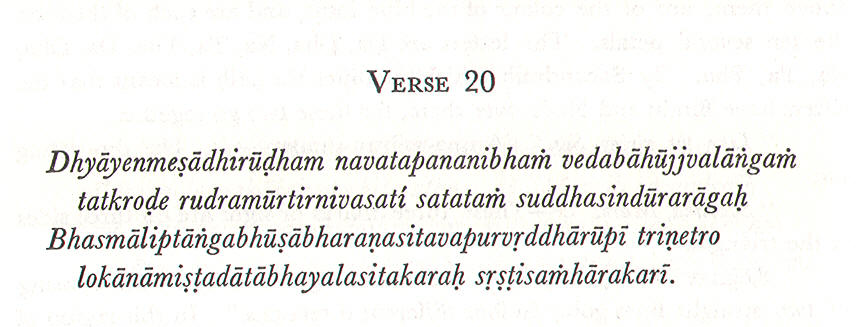
20.Dyāyenmeşādhirūdham navatapanaibhaṁ vedabāhūjvalāṇgaṁ
tatkroḍe rudramūrtiirnivasatī satataṁ suddhasindūrarāgaḥ
Bhasmāliptāṅgabhūşābharaṇasitavapurvṛddhārūpī triṇetro
lokānāmişṭadātābhayalsitakaraḥ sṛşṭstisaṁhārakarī.
Meditate upon him (Fire) seated on a ram, four-armed, radiant like the rising Sun. In his lap ever dwells Rudra, who is of a pure vermilion hue. He (Rudra) is white with the ashes with which he is smeared; of an ancient aspect and three-eyed. His hands are placed in the attitude of granting boons and dispelling fear1. He is the destroyer of creation.
granting boons and dispelling fear1 = the deities exhibit hand poses that give boons (Vara) and quell Fear (Abhaya Mudra)
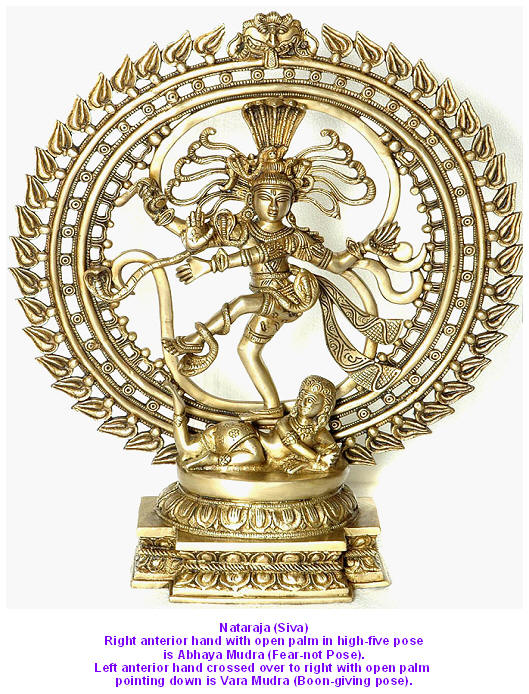
Meditation on Vahni (Fire): Seated on a ram, a Rudraksa rosary in one hand, and Sakti in the other. The other two hands holding no weapons grant boons and quell fear. Rudra is never meditated upon as seated on a bull.
Bhasmaliptanga-bhusabharana-sita-vapu = His body is smeared with ash; His ornaments makes Him look white, though he is of red hue.

21. Atrāste lākinī sā sakalaśubhakarī vedabāhūjjvalāṅgī
śyāmā pītāmbarādyairvividhaviracanālaṁkṛta mattacittā
Dhyātvaitannābhipadmaṁ parabhavati nitarāṁ saṁhṛtau pālane vā
vāṇī tasyānanābje nivasati satataṁ jñānasaṁdohalakşmiḥ.
Here abides Lakini, the benefactress of all. She is four-armed, of radiant body, is dark (of complexion), clothed in yellow raiment and decked with various ornaments, and exalted with the drinking of ambrosia. By meditating on this Navel Lotus the power to destroy and create (the world) is acquired. Vani with all the wealth of knowledge ever abides in the lotus of His face.
Vani = Sarasvati , Devi or Goddess of speech.
lakini = lakini is meditated upon as follows. Let the excellent worshipper meditate upon the Devi Lakini, who is blue and has three faces, and three eyes on each face, fierce aspect, and with the teeth protruding I. Her right hand She holds the thunderbolt and the Sakti (the weapon of Vahini (Fire) and in the left She makes gestures (mudra) of dispelling fear and of granting boons. She is in the pericarp of the navel Lotus with ten petals. She is fond of meat (Mamasi) and Her breast is ruddy with blood and fat which drop from Her mouth.
The navel lotus is called Mani-pura, the city of jewels because it is lustrous like a gem.
vividhaviracanālaṁkṛta = Decked with various ornaments. All her ornamets (pearsls and gems) are arranged in varied and beautiful designs.
Summary of Verses 19 to 21.
The Nabhi Padma--Navel Lotus--is rain-cloud-colored with ten lustrous blue petals having on them the letters: Ḍa, Ḍha, Na, Ta, Tha, Da, Dha, Na, Pa, Pha with Bindu above each of them. Triangular-shaped red region of Fire with Svastika signs on its three sides is in the pericarp, within which is the four-armed Bija of Fire, Ram, who is red in color, sits on a ram, holds in Hsi hands the Vajra (thunderbolt) and the Sakti weapon and makes signs of Vara and Abhaya. Rudra red in color sits on a bull on the lap of Vahni-Bija, is smeared with ash and appears old. Sakti Lakini sits on a red lotus in the pericarp. She is blue, four-armed, three-faced with three eyes on each face, holds the Vajra and Sakti weapons in her two hands and makes abhaya and Vara mudras with the other two hands. She is fierce with protruding teeth, is fond of eating cooke rice and dhal mixed with meat and blood. Here ends the third section.
ANAHATA
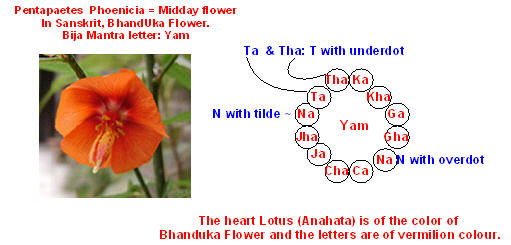

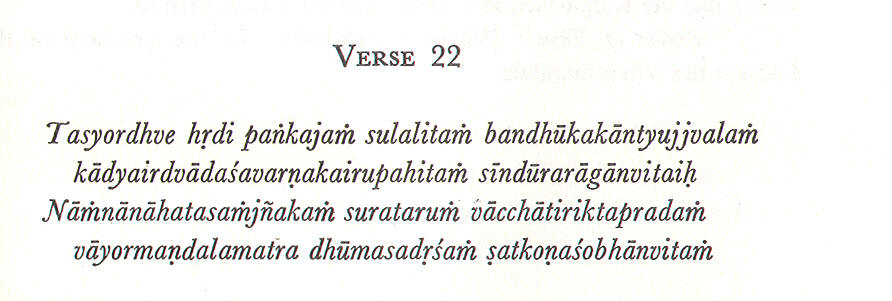
22. Tasyordhve hṛdi paṅkajaṁ sulalitaṁ bandhūkakantyujjvalaṁ
kādyairdvādaśavarṇakairupahitaṁ sīndūrarāganvitaiḥ
Nāṁnāṇāhatasamjñakaṁ surataruṁ vācchātiriktapradaṁ
vāyormaṇdalamatra dhūmasadṛśaṁ şatkoṇaśobhānvitaṁ
Above that, in the heart, is the charming Lotus, of the shining colour of the Bandhuka flower, with the twelve letters beginning with Ka, of the colour of vermilion, placed therein. It is known by the name of Anahata, and is like the celestial wishing-tree, bestowing even more than (the supplicant's) desire. The Region of Vayu, beautiful and with six corners, which is like unto the smoke in colour, is here.
charming Lotus: Verses 22 to 27 describes Anahata Lotus Chakra, which is meditated upon in the heart. The 12 letters from Ka to Tha are on the petals: Ka, Kha, Ga, Gha, Ña, Ca, Cha, Ja, Jha, Na, Ṭa, Ṭha. wishing-tree = Kalpa-taru is a wish-tree in the garden (heaven) of the chief of gods Indra. It grants all that is wished for and Moksa (liberation). six corners = see the interlacing triangles with six corners (Sat-kona).

hṛdi paṅkajaṁ = Heart Lotus. dvādaśavarṇa= 20 letters. Nāṁnāṇāhata-samjñakaṁ: name Anahata it is known. Munis called the Lotus Anahata because they heard the sound of sabdabrahman in the Heart Lotus; it is Unstruck Sound, meaning that the sound is not produced by two clanging objects. vāyormaṇdalaṁ = Vayu Mandalam or Region of Air.
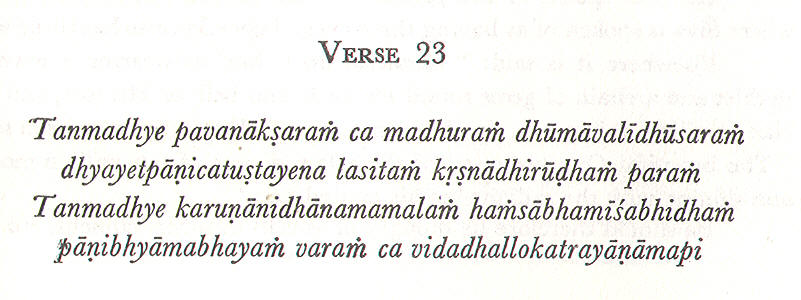
23. Tanmadhye pavanākşaraṁ ca madhuraṁ dhūmāvalīdhūsaraṁ
dhyayetpāṇicatuştayena lasitaṁ kṛşnādhirūḍhaṁ paraṁ
Tanmadhye karuṇānidnamamalaṁ haṁsābhamiśabhidhaṁ
pāṇibhyāmabhayaṁ varaṁ ca vidadhallokatrayāṇāmapi
Meditate within it on the sweet and excellent Pavana Bija, grey as a mass of smoke, with four arms, and seated on a black antelope. And within it also (meditate) upon the Abode of Mercy, the Stainless Lord who is lustrous like the Sun, and whose two hands make the gestures which grant boons and dispels the fears of three worlds.
Purnananda Svami says that VAyu Bija is in the Anahata Chakra. Pavana Bija = The Bija of Yam, grey as a mass of smoke. the Abode of Mercy = Sankara opines that it is a Ocean of Mercy (Kripa Sagar or KarunAvAridhi).Sun = Sun is Hamsa and also the name of the Supreme. Ham means motion. It is Aditya (sun) because it is perpetual motion (SAyana). Hamsa is also AntarAtmA (the Inner Atman or Soul, Paramatman). Hamsa is Mantra of every breath. This chantless Mantra pervades the breath going in and out, the subtle sound ‘sah’ going in and the subtle sound ‘ham’ going out. (Sa = Siva, Vishnu, Lakshmi, or Gauri [Parvati or Sakti]; Ham = I am; so = Parvati.} As one chants this subtle-sound Mantra ‘soham’, a derivative of ‘sah-ham,’ ‘Hamsa’ comes into being by inversion. Sa (Sah) is Sakti and Ha is Siva. Soham, Hamsa and AUM (Pranava) are equipotent. Hamsah is the union of male and female and the universe is Hamsah, according to Woodroffe. Tirumular says that AUM, though a three-letter word, is one-letter Mantra. Soham is the unintonated sound of normal breathing, meaning ‘I am He.’ Hamsa, meaning ‘Swan’ as in RamaKrishna Parma-Hamsa, stands for an ascetic --Hamsan. All of us including all air-breathing living beings recite this Mantra ‘Soham’ unknowingly for a lifetime. This chantless Mantra (Ajapa Japa) is called Ajapa Gayatri. As you are breathing this chantless Soham in and out, you are identifying your individual self with the Great Self of the Supreme Being. Every breath (and the Mantra) that you take pervades the whole universe of your body. This life giving force or Mantra has the Great Self as the basis. two hands = Bija has hands and feet.
Verse Explanation: pavanākşaraṁ = the letter of Pavana (Air). It is Bija Yam. madhuraṁ = sweet and excellent. dhūmāvalīdhūsaraṁ = Dhuma is smoke. Grey as a mass of smoke.
The black antelope, known for its fleetness is the Vahana (carrier) of Vayu (Air), whose carries his Ankusa (goad) in the same way Varuna carries his PAsa (noose). Isa (Siva) is in Vayu Bija.
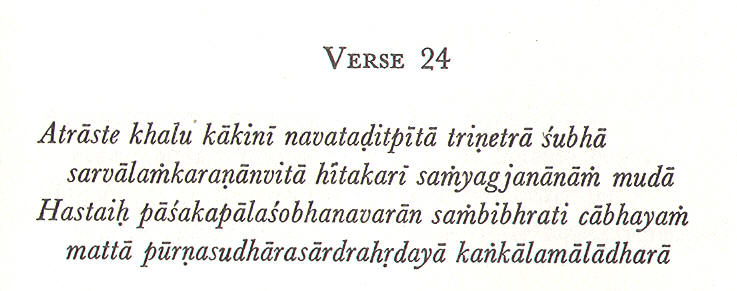
24. Atrāste khalu kākinī navataḍitpītā triṇetrā śubhā
sarvālaṁkaraṇānvitā hītakari saṁyagjnānāṁ mudā
hastaiḥ pāśakapālaśobhanavarān saṁbibhrati cābhyaṁ
mattā pūrṇasudhārasārdrahṛdayā kaṅkālamālādharā
Here dwells Kakini, who in colour is yellow like unto new lightning, exhilarated and auspicious; three-eyed and the benefactress of all. She wears all kinds of ornaments, and in Her four hands She carries the noose and the skull, and makes the sign of blessing and the sign which dispels fear. Her heart is softened with the drinking of nectar.
Pandit Purnananda Svami says that there is Sakti Kakini in Anahata Chakra. mattā = exhilarated. Kakini is exhilarated. pūrṇasudhārasārdrahṛdayā = Totally Pure nectar softens her heart. The nectar flows from Sahasrara Chakra. She wears the skin of a black antelope.
Meditate on Kakini, who is in the Fat holding in her hands a noose (PAsa), trident (SUla), skull (KapAl), Drum (Damaru). She with a bending pose, is of yellow complexion, likes to eat Dadhy-anna (curd and rice) drink VAruni (Rice wine). The Seven Saktis or Yoginis have each an abode in one of the Dhatus (layer, stratum, constituent part , ingredient): chyle , blood , flesh , fat , bone , marrow , semen of which sometimes 10 are given , the above 7 and hair , skin , sinews (tendon).

25. Etannīrajakarṇikāntaralasacchaktistrikoṇābhidha
vidyutkotisamānakomalavapuḥ sāste tadantargataḥ
Baṇākhyaḥ śivalinṅgakoऽpi kanakākārāṅgarāgojjvalo
maulau sūkşma-vibheda-yuṅ maṇiriva prollāsalakşmyālayaḥ
The Sakti whose tender body is like ten million flashes of lightening is in the pericarp of this Lotus in the form of a triangle (Trikona). Inside the triangle is the Siva-Linga known by the name of Bana. This Linga is like shining gold, and on his head is an orifice minute as that in a gem. He is the resplendent abode of Laksmi.
Pandit Purnananda Svami tells of the triangle (Trikona) in the pericarp of Anahata Lotus. trikoṇābhidha = In the form of a triangle. Sakti appears as a down triangle with apex down. The down Triangle is symbolic of female escutcheon or Yoni which also appears like an inverted triangle, which is below Vayu-Bija. Within the Triangle is the BAna-Linga. maulau sūkşma-vibheda-yuṅ maṇiḥ = on his head is a minute orifice as that in a gem. vibheda = piercing. sūkşma = minute. maṇiḥ = jewel. This is the description of Bāna-Linga. The orifice is the little space in the Bindu which is within the half-moon which is on the head of the Linga. The Bindu is in the head of Siva-Linga. prollāsalakşmyālayaḥ = Resplendent abode of Lakshmi. Alaya = temple, abode,
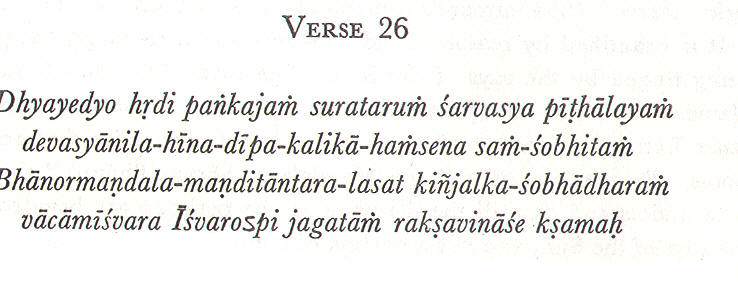
26. Dhyayedyo hṛdi paṅkajaṁ surataruṁ śarvasya pīthālayaṁ
devasyānila-hīna-dīpa-kalikā-haṁsena saṁ-śobhitaṁ
bhānormaṇdala-maṇditāntara-lasat kiñjalka-śobhādharaṁ
vācāmīśvara īśavaroऽpi jagatāṁ rakşavināśe kşamaḥ
He who meditates on this Heart Lotus becomes (like) the Lord of Speech, and (like) Isvara he is able to protect and destroy the worlds. This Lotus is like the celestial wishing-tree, the abode and seat of Sarva. It is beautified by the Hamsa, which is like unto the steady tapering flame of a lamp in a windless place. The filaments which surround and adorn its pericarp, illumined by the solar region, charm. Sarva = Maha-Deva = Siva. Hamsa = Here it stands for Jivatma.
Pandit Purnananda Svami talks about the good gained by meditating on the Heart Lotus. Dhyayedyo hṛdi paṅkajaṁ surataruṁ śarvasya pīthālayaṁ = He who meditates on this Heart Lotus becomes (like) the Lord of Speech, and (like) Isvara he is able to protect and destroy the worlds. anila-hīna-dīpa-kalikā-haṁsena saṁ-śobhitaṁ = Hamsa (Jivatma) is like the steady flame of lamp in a widless place, and enhances the beaty of this Lotus. Surya Mandala is in the pericarp of Anahata Lotus. bhānormaṇdala-maṇditāntara-lasat kiñjalka-śobhādharaṁ = The filaments which surround and adorn its pericarp, illumined by the solar region, charm. The filaments surrounding the pericarp tinged with the rays of the sun give beauty and charm. Anahata Lotus filaments around the pericarp are the only ones thus tinged by the rays of the sun and other filaments of other lotuses are not so touched by the Sun's rays. BhAnu Mandala = Sun Mandala. The region of Vayu covers the whole pericarp. Above it is region of Surya or sun. Above them are the Vayu-Bija and Trikona etc. One should meditate upon all these. Mam is the Mantra of mental worship in the region of Fire with his ten KalAs. Kala = digit, part, portion. The regions of Vahini (Fire), Arka (Sun), and Chandr (Moon) are placed one above the other. īśavar = Creator. rakşavināśe kşamaḥ = Equally able to protect and destroy the world. he can create, maintain and destroy the Universe.
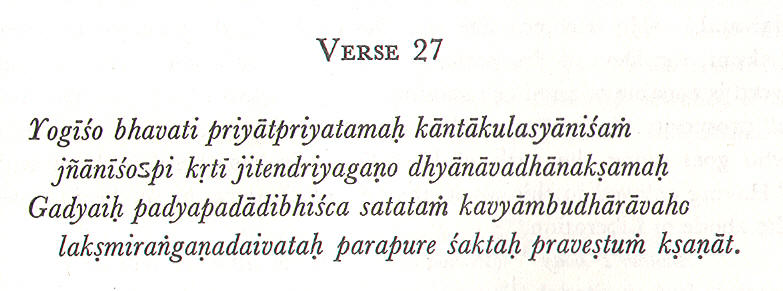
27. Yogīśo bhavati priyātpriyatamaḥ kāntākulasyāniśaṁ
jñānīśoऽpi kṛti jitendriyagaṇo dhyānāvadhānakşamaḥ
Gadyaiḥ padyapadādibhiśca satataṁ kavyāmbhudhārāvaho
lakşmiraṅgaṇadaivataḥ parapure śaktaḥ praveştuṁ kşaṇāt.
Foremost among Yogis, he is ever dearer than the dearest to women, He is pre-eminently wise and full of noble deeds. His senses are completely under control. His mind in its intense concentration is engrossed in thoughts of the Braham. His inspired speech flows like a stream of (clear) water. He is like the Devata who is the beloved of Laksmi and is able at will to enter another's body. Laksmi = Lakshmi is the family Devata, meaning he is always prosperous.
priyātpriyatamaḥ kāntākulasya = dearer than the dearest to women (because he is skilful to please them). Sankara says that he is dearer than their husbands. jitendriya-gaṇḥ = His senses are completely under control. dhyānāvadhāna-kşamaḥ = His mind in its intense concentration is engrossed in thoughts of the Braham. Dhyana is meditation --Brahma-Cintana, and AvadhAna means steady and intense concentration of the mind. The yogi is capable of both. kavyāmbhu-dhārā-vaha = His inspired speech flows like a stream of (clear) water. lakşmī-raṅgaṇa-daivataḥ = He is like the Devata who is the beloved of Laksmi. Slakshmi is the consort of Vishnu. Rangana is good fortune. Having enjoyed in this world th best of pleasure, he in the end goes to the abode of Liberation. parapure = another's body. He is able at will to enter another's body. He gains power to render himself invisible, enter an enemy's fortress, and fly across the sky.
Summary of Verses 22 to 27 on Anahata Chakra.
The Heart Lotus of the color of Bhaduka Flower has vermilion letters from Ka to Tha on its 12 petals with Bindu above them. Hexagonal Vayu Mandala of smoky color is in its pericarp; above it is Surya Mandala with the Triangle shining like ten million flashes of lightning within it. Above it is Vayu-Bija of smoky hue sitting on a black antelope, four armed and carrying a goad (Ankusa). In the lap of Vayu-Bija abides three-eyed Isa who like Hamsa extends His two arms in gestures of granting boons and dispelling fear. In the pericarp of the Anahata Lotus is another red lotus wherein abides four-armed Sakti Kakini of golden hue, yellow raiment, many jewels and garland of bones carrying PAsa (noose), the KapAla (skull), and making Vara (boons) and Abhaya (fear-not) signs. Her heart is softened by the nectar. Golden-colored Siva in the form Bana-Linga with crescent moon and Bindu on his forehead abides in the middle of the triangle. He is joyous with a rush of desire. Hamsa Jivatma below him is like the steady tapering flame of a lamp. Below the pericarp, there is a red lotus of 8 petals with its head turned upward which contains the Kalpa tree, the jeweled altar surmounted with an awning, flags and the like and is the place of mental worship.
VISUDDHA


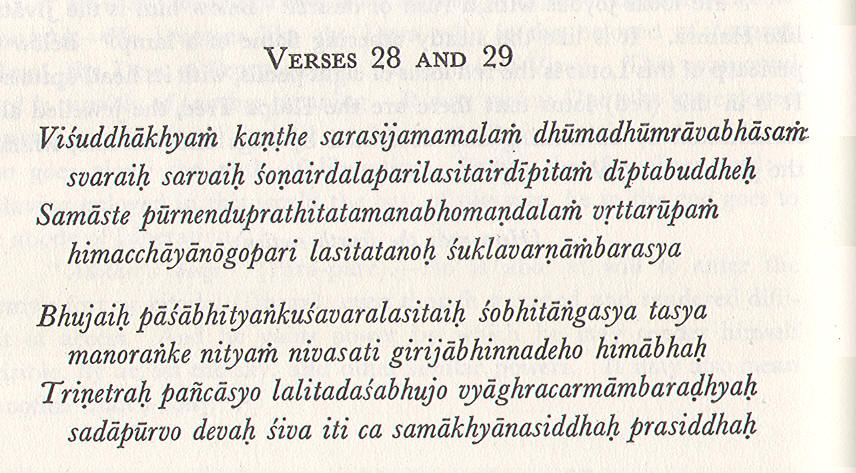
28. Viśuddhākhyaṁ kaṇṭhe sarasijamamalaṁ dhūmadhūmrāvabhāsaṁ
svaraiḥ sarvaiḥ śoṇairdalaparilasitairdīpitaṁ dīptabuddheḥ
Samāste pūrneneduprathitatamanabhomaṇḍalaṁ vṛttarūpaṁ
himacchayanāgopari lasitatanoh suklavarnambarasya
29. Bhujaiḥ pāśābhītyaṅkuśavaralasitaiḥ śobhitāṅgasya tasya
manoraṅke nityaṁ nivasati girijābhinnadeho himābhaḥ
Triṇetraḥ pañcāsyo lalitadaśabhujo vyāghracaramāmbaraḍhyaḥ
sadāpūrvo devaḥ siva iti ca samākhyānasiddhaḥ prasiddhaḥ
In the throat is the Lotus called Visuddha, which is pure and of a smoky purple hue. All the (sixteen) shining vowels on its (sixteen) petals, of a crimson hue, are distinctly visible to him whose mind (Buddhi) is illumined. In the pericarp of this lotus there is the Ethereal Region, circular in shape, and white like the full Moon. On an elephant white as snow is seated the Bija of Ambhara, who is white of colour.
Of His four arms, two hold the noose and goad, and the other two make the gestures of granting boons and dispelling fear. These add to His beauty. In His lap there ever dwells the great snow-white Deva, three-eyed and five-faced, with ten beautiful arms, and clothed in a tiger's skin. His body is united with that of Girija, and He is known by what His name, Sada-Siva, signifies.
full Moon: Ether, whose Mandala is a circle (Vrrta-rupa), is the element of Visuddha Lotus Chakra. Bija = Ham is the Bija of Visuddha. Ambhara = Ethereal region. also means raiment. Ambhara, white in his Bija form wearing white raiment, sits on a elephant of the color of snow. His lap: Ham (Nabho-Bija). Girija = Giri is mountain. Mountain-born Devi. Daughter of Mountain King Himavat (Himalaya Mountains). This refers to Androgynous from of Siva-Sakti. Sada-Siva = Ever-Beneficent One.
Four verses from 28 to 31 describes Visuddha Lotus Chakra. Hamsa (the Jiva) attains purity, so this lotus is called Visuddha (pure), Ethereal, Great, and Excellent. Visuddha in the region of the throat is called Visuddha: Pure (amala = without impurity) by reason of its being tejo-maya (purified by Fire and its substance is Tejas) and hence free from impurity. svaraiḥ sarvaiḥ = all the vowels, beginning from A-KAra (A) ending with Visarga, altogether 16 in number. dala-parilasitaiḥ = shining on the petals, 16 in number and red in color with Bindu above them. Its filaments are ruddy and it is adorned by Vyoma-Mandala. Vyoma = Ether. Mandala = region or circle. dīpitam= Distinctly visible. The letters are lighted up as it were for the enlightened mind (Dīpta-Buddhi). dīptabuddheh = Whose mind (Buddhi = Intellect) is illumined. The intellect has become free of impurities of worldly pursuits as a result of constant practice of Yoga. pūrnenedu-prathita-tama-nabhomaṇḍalaṁ vṛtta-rūpaṁ = the Ethereal Region, circular in shape, and white like the full Moon. purnenedu = Full-Moon. nabhomaṇḍalaṁ = Ethereal Region. vṛtta-rūpaṁ = Circular in shape. Various texts have assigned different colors to Ethereal region: white, smoky. hima-cchayanāgopari lasita-tanu = On an elephant white as snow is seated. Nāga is not a serpent but an elephant in this context.
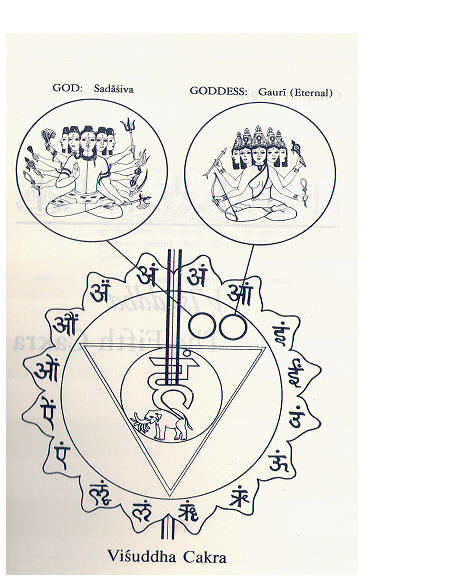
Bhujaih pasabhityankusa-vara-lasitaih sobhitangasya (Bhujaiḥ pāśābhītyaṅkuśa-vara-lasitaiḥ śobhitāṅgasya) = Of His four arms, two hold the noose and goad, and the other two make the gestures of granting boons and dispelling fear. These add to His beauty. tasya manoh = His Mantra = The Bija of Ambara or Ether = Ham. The Bija (root) of a thing is that thing in essence. tasya manor anke = In the lap of His Bija. Ham is Bija of Ether in the pericarp of Visuddha Lotus and we are to meditate on it. girijabhinna-deha (girijābhinna-deha) = the snow-white Deva whose body is united with or inseparable from that of Girija. This means Siva-Sakti body is androgynous, of golden color on the left (Sakti) and snow-white on the right (Siva). He, Sadasiva with white garment, dwells in the lap of Nabho-Bija. Nirvana Tantra says: Within the Yantra (AmA KalA) is the Half-Bull and half-Lion (Simhasana), on which sits the Eternal Gauri (Sakti on half-lion) with Sada-Siva on Her right (on half-bull). Sadasiva has five faces, three eyes in each face, a body smeared with ash, looks like a mountain of silver, and wears the skin of a tiger and a garland of snakes as His ornaments. The Eternal Gauri (SadA-Gauri), half of Siva's body, is the Mother of the Universe. lalita-dasa-bhuja (lalita-daśa-bhuja) = beautiful-ten-arms. Meditate on Him as Deva with ten arms carrying the following weapons, accouterments and offering boons. Ten beautiful arms carry the following.
| Sula | Tanka | Krpana | Vajra | Dahana | Nagendra | Ghanta | Ankusa | Pasa | Abhitikara |
| Trident | Battle-axe | Sword | Thunderbolt | Fire | Snake-King | Bell | Goad | Noose | no-fear sign |
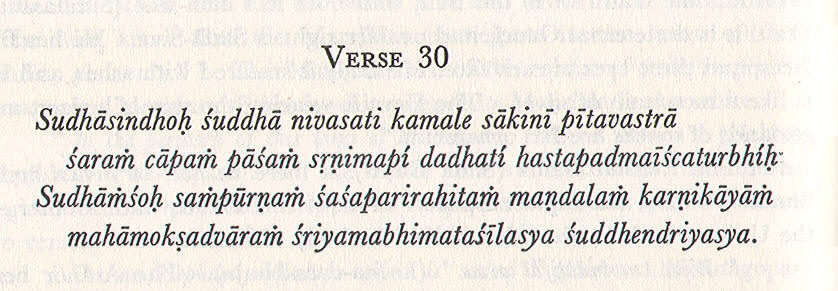
30. Sudhāsindhoḥ suddha nivasati kamale sākinī pītavastrā
śaram cāpaṁ pāśam sṛṇimapi dadhatí hastapadmaīścaturbhíḥ
sudh|mśoḥ saṁpūrṇaṁ śaśaparirahitaṁ maṇdalaṁ karṇikāyāṁ
mahāmokşadvāraṁ śriyambhimataśīlasya śuddhendriyasya.
Purer than the Ocean of Nectar is the Sakti Sakini who dwells in this Lotus. Her raiment is yellow, and in Her four lotus-hands She carries the bow, the arrow, the noose, and the goad. The whole region of the Moon without the mark of the hare is in the pericarp of this Lotus. This (region) is the gateway of great Liberation for him who desires the wealth of Yoga and whose senses are pure and controlled. hare = hare on the moon, stain on the moon, man on the Moon.
Swami Purnananda says that Sakini abides in the pericarp of Visuddha Lotus Chakra.
Sudhasindhoh suddha ( Sudhāsindhoḥ suddha) = Purer than the ocean of Nectar. Sudhasindhu is Chandra or Moon according to Sankara. She is purer and whiter than the nectar in the moon. Sakini who is of the form of light itself (Jyotih-svarupa) is white and heatless. Meditation on Sahini is as follows: "Let the excellent Sadhaka meditate on the Devi Sakini in the Throat Lotus. She is Light itself. She carries in Her Lotus hands the noose, the goad, the sign of the book and makes Jnana-Mudra (thumb and pinky touching at the tips). She makes the Pasus (the uninitiated people) mad and has her abode in the bone (She is the Devata of Asthi-Dhatu. She is fond of milk food and gets drunk and elated on the nectar." The Devi (Sakti Sakini) is the Lunar Region within the pericarp. kamale = in this Lotus. in the pericarp of the Visuddha Chakra. sasa-pari-rahita = In this pericarp is the spotless region of the Moon, without the mark of a hare. maha-moksa-dvaram (mahā-mokşa-dvāraṁ ) = Great-heaven-gate. The gateway to Great liberation-- Nirvana Mukti (in the praise of this Mandala) for those who have purified and conquered their senses, among other practices; by meditating in this in the path of Yoga, they attain Liberation (mukti). sriyambhimata-silasya (śriyambhimata-śīlasya) = Who desires the wealth of Yoga. Sri is wealth (of Yoga). That nature is the gateway to liberation. suddhendriya (śuddhendriya) = Suddha + Indriya = Pure + Senses. Whose senses are pure and controlled.
In the pericarp of the Lotus of Nabho-Mandala: inside the latter is the triangle, inside which is the Chandra-mandala, inside which is Nabho-Bija (Ham). Think of the full-moon in the triangle within the pericarp; there think of the snowy Akasa seated on the elephant, whose raiment is while. There is the Deva Sada-Siva whose raiment is white--qualifies Akasa. 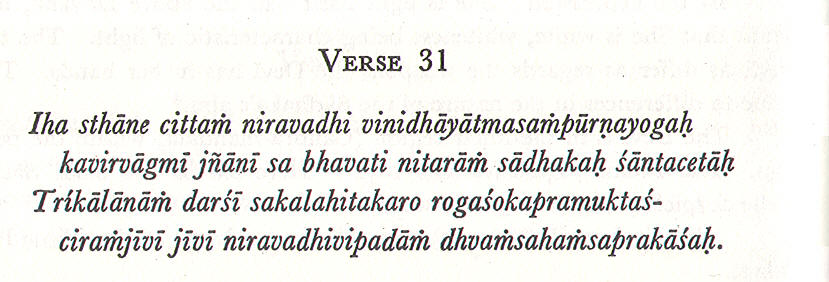
31. Iha sthāne cittam niravadhi vinidhāyātmasampūrṇayogaḥ
kavirvāgamī jñānī sa bhavati nitarāṁ sādakaḥ śāntacetāḥ
Tríkālānāṁ darśī sakalahitakaro rogaśokapramuktaś-
ciramjīvī jīvī niravadhivipadāṁ dhvaṁsahaṁsaprakāśaḥ.
He who has attained complete knowledge of the Atma (Brahman) becomes by constantly concentrating his mind (Citta) on this Lotus a great Sage, eloquent and wise, and enjoys uninterrupted peace of mind. He sees the three periods, and becomes the benefactor of all, free from disease and sorrow and long-lived, and, like Hamsa, the destroyer of endless dangers.
Svami Purnananda speaks of the good gained by meditating on the Visuddha-Chakra.
atma-sampurna-yoga (ātma-sampūrṇa-yoga) = who has attained complete knowledge of the Atman (Brahman) by virtue of the fact that Brahman is all-pervading. Another meaning is One who has obtained perfection Yoga. The one who has attained complete knowledge of Atma reposes like the still waters of the deep. Such a person is a Knower (Jnani). He becomes proficient of all Sastras without instruction therein. "He becomes merciful not looking for any rewards; his Citta is peaceful; He is constant, gentle, modest, courageous, forgiving, self-controlled, pure and the like, and free from greed, malice and pride." Bhagavad-Gita16.2 & 3. Tri-kala darsi (Tri-kāla darśī )= three-periods-seer. he sees the three periods-Past, present and future. He sees the Atma (Self) and all objects of knowledge therein. roga-soka-pramuktah (roga-śoka-pramuktah) = Disease-Sorrow-the Liberated. Free from disease and sorrow--by having attained Siddhi (Spiritual perfection) in his Mantra. He is free of MAyA and thus feels no sorrow. niravadhi-vipadam-dhvamsa-hamsa-prakasah (niravadhi-vipadāṁ dhvaṁsa-haṁsa-prakāśaḥ)_ = endless-dangers-destroying-Hamsa-showing, shining. Like Hamsa, the destroyer of endless dangers. The Sadhaka becomes Hamsa Which is the Antartma (Inner Soul) that dwells by the pericarp of the Sahasrara for he can destroy all such dangers and in the result open the gate of Liberation. Sankara calls Hamsa Sun. Hamsa is the 12-petalled Lotus below Sahasrara.
Summary of the Visuddha Chakra
Visuddha Chakra is in the base of the throat with ruddy filaments, and 16 petals of smoky purple hue and 16 red Vowels on the petals with Bindu above them. Circular and white Nabho-Mandala is in the pericarp inside which is Chandra Mandala with elephant-mounted white, garmented and four-armed Bija Ham above it, which holds in four hands noose and goad, and makes Vara and Abhaya Mudras. In his lap is Sada-Siva seated on a great lion-seat placed on the back of the bull. He is in the form of Ardha-narisvara; half the body snow-white Siva and the other half golden Sakti, with five faces, ten arms holding trident, battle-axe, sacrificial sword, thunderbolt, the great snake, bell, goad, noose, and making Abhaya-mudra. He wears a tiger's skin, ash all over His body, a garland of snakes round His neck, and a down-turned digit of moon on His forehead dropping the nectar. Within the pericarp and in the Lunar region and seated on bones, is Sakti Sakini, white in color, four-armed, five-faced and three-eyed on each face, clothed in yellow and carrying in Her hand a bow, an arrow, a noose, and a goad.
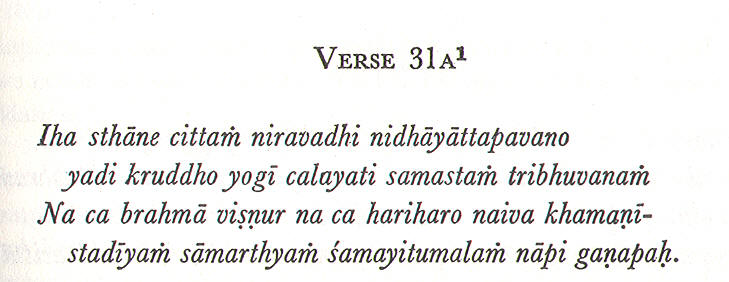
31. Iha Sthne cittaṁ niravadhi nidhāyāttapavano
yadi kruddho yogī calayati samastaṁ tribhuvanaṁ
Na ca brahmā vişṇur na ca hariharo naiva khamaṇī-
stadīyaṁ sāmarthyaṁ śamayatumalaṁ nāpi gaṇapaḥ.
The Yogi, his mind constantly fixed on this Lotus, his breath controlled by Kumbhaka (retention of breath), is in his wrath able to move all the three worlds. Neither Brahma nor Visnu, neither Hari-Hara nor Surya (sun) nor Ganapa (Ganesa) is able to control his power (resist Him). wrath = This is SturivAda = praise of his great powers. If He were to get angry, he could move the three worlds.
Swami Purnannda speaks of the power of Yogi.
Ātta-pavana = his breath controlled by Kumbhaka (retention of breath in Pranayama--breath control). harihara = The Yugala--combined--form of Vishnu and Siva. khamani = the jewel of the sky = the sun.
End of 5th section.
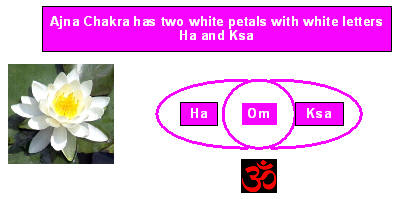
AJNA
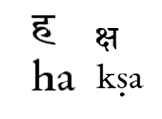 are the letters on the petals. ! Om is the Bija letter of Ajna Chakra.
are the letters on the petals. ! Om is the Bija letter of Ajna Chakra.

32. Ājñanāmāmbujaṁ taddhimakarasadṛśam dhyānadhāmaprakāśaṁ
hakşābhyāṁ vai kalābhyāṁ parilasitavapurnetrapatraṁ suśubhraṁ
Tanmadhye hākinī sā śaśisamadhavalā vaktraşaṭkaṁ dadhānā
vidyāṁ mudrāṁ kapālaṁ ḍamarujapavaṭīṁ bibhrtī śuddhacittā.
The Lotus named Ajna is like the moon (beautifully white). On its two petals are the letters Ha and Ksa, which are also white and enhance its beauty. It shines with the glory of Dhyana (meditation). Inside it is the Sakti Hakini, whose six faces are like so many moons. She has six arms, in one of which She holds a book; two others are lifted up in the gestures of dispelling fear and granting boons, and with the rest She holds a skull, a small drum, and a rosary. Her mind is pure (Suddha-Citta). Ajna = Command. Name of the Lotus between the eyebrows above Visuddha Chakra. book = Pustaka-Mudra. A hand gesture of Vidya or knowledge.
Swami Purnananda talks about Ajna Chakra from Verse 32 to 38
Verses 32 to 38 describes Ajna Chakra. Ajnanama (Ājña-nāmā) = Ajna name. The Lotus named Ajna. Ajna or Command of the Guru comes down (GurorAjneti) to this Lotus between the eyebrows. Going upwards after entering the throat and palate, the white and auspicious lotus (the place of manas, the mind) between the eyebrows is reached by Kundali. Its 2 petals have Ha and Ksa on them. himakara-sadrsam (hima-kara-sadṛśam) = Like the moon, beautifully white. or Cool like the moonbeams. Hima-kara is Moon. Hima means cool; Kara means causer. The moon is the receptacle of Ambrosial nectar and cool and beautifully white. dhyana-dhama-prakasam (dhyāna-dhāma-prakāśaṁ) = it shines with the glory of Dhyana. Its body shines like the glory of Dhyana Sakti. netrapatraṁ = two petals. Netra = eye. Ha-ksabhyam kalabhyam-parilasitavapuh-susubhram = (Ha-kşābhyāṁ kalābhyāṁ parilasitavapuh su-śubhraṁ) The letters Ha and Ksa which are also white. Hakini sa ( hākinī sā) = She is Hakini, the resident Devata of the Ajna Chakra. mudram (mudrā) = hand poses depicting granting of boons and dispelling fear. vidyam-mudram = this may also mean the hand pose of Knowledge.
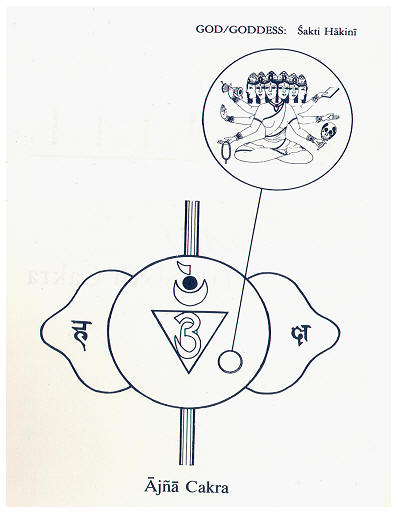
Meditate on Sakti Hakini who is white, abides in the marrow, and holds in her hands the Damaru, the Rosary, the Skull, the Vidya (sign of the book) and the Mudra (hand pose of granting boons and dispelling fear). She has six red faces with three eyes in each. See below. She sits on a white lotus, and likes food cooked with Turmini and feels elated by drinking ambrosia.

33. Etatpadmāntarāle nivasati ca manaḥ sūkşmarūpaṁ prasiddhaṁ
yonau tatkaraṇikāyāmitaśivapadaṁ liṅgacihṇaprakāśaṁ
Vidyunmālāvilāsaṁ paramakulapadaṁ brahmasūtraprabhodaṁ
vedānāmādibījaṁ sthiratarahṛdayaścintayettatkrameṇa.
Within this Lotus dwells the subtle mind (Manas). It is well-known. Inside the Yoni in the pericarp is the Siva called Itara, in His phallic form. He here shines like a chain of lightning flashes. The first Bija of the Vedas, which is the abode of the most excellent Sakti and which by its lustre makes visible the Brahma-sutra, is also here. The Sadhaka with steady mind should meditate upon these according to the order (prescribed).
Swami speaks of the Manas, the Mind in Ajna Chakra. Swami Purnananda talks about Ajna Chakra from Verse 32 to 38.
Etatpadmantarale nivasati ca manah suksmarupam prasiddham (Etatpadmāntarāle nivasati ca manaḥ sūkşmarūpaṁ prasiddhaṁ) = Within this Lotus dwells the subtle mind (Manas). The Manas is beyond the scope of the senses. What is the proof of its existence? It is universally accepted (prasiddha) and handed down from AnAdi-Purusa as realized thing. Manas is above the First Bija of the Vedas. linga-cihna-prakasam (liṅga-cihṇa-prakāśaṁ) = shining Phallic form. Sivalinga is in the Yoni within the pericarp. The Itara-Siva in Linga form is within the Yoni. Itara-Sivapada within the triangle in the pericarp is white and crystalline with three eyes. Vidyun-mala-vilasam (Vidyun-mālā-vilāsaṁ) = Linga resembles continuous streaks of lightning flashes. parama-kula-padam = Excellent-Kula-place. which is the abode of the most excellent Sakti. Kula is Sakti of Triangular form. Akula is not Sakti but Siva. Atma is in the form of Pranava in the triangle in the pericarp. Above it, the flaming lamp is the charming NAda and Bindu is MakAra (M of AUM). Manas abode is above these. vedanam-adibijam (vedānāmādibījaṁ) = First Bija of the Vedas. It refers to M of Pranava (AUM) in the pericarp pf the lotus. brahma-sutra-prabhodam (brahma-sūtra-prabhodaṁ)= makes visible the Brahma-sutra. Brahma Sutra is Brahma thread or Citrini Nadi. Sutra is thread and cognate with suture. The luster of Pranava makes the Sutra visible.
The SAdaka should meditate on all of these: Hakini in the pericarp, Manas, Itara Linga and Pranava in the order prescribed.
The vertical linearity of the entities are from below up: First Hakini in the pericarp, Itara Linga in the triangle above her, Pranava in the triangle above Him, Manas at the top.
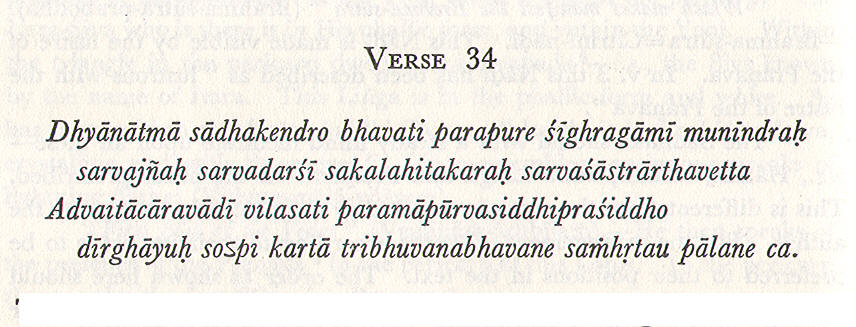
34. Dhyānātmā sādhakendro bhavati prapure śighragāmī munindraḥ
sarvajñah sarvadarśī sakalahitakarah sarvaśāstrarthavettā
Advaitācāravādī vilasati paramāpūrvasiddhipraśiddho
dīrghāyuḥ soऽpi kartā tribhuvanabhavane saṁhṛtau pālane ca.
The excellent Sadhaka, whose Atma is nothing but a meditation on this Lotus, is able quickly to enter another's body at will, and becomes the most excellent among Munis, and all-knowing and all-seeing. He becomes the benefactor of all, and versed in all the Sastras. He realises his unity with the Brahman and acquires excellent and unknown powers. Full of fame and long-lived, he ever becomes the Creator, Destroyer, and Preserver, of the three worlds.
Swami Purnananda talks about the benefits of meditating on Ajna Lotus, from Verse 32 to 38.
munindrah = the most excellent among Munis. Muni literally means the silent one. Maunam is silence. Muni, the silent Yogi is accomplished in meditation and Yoga. Muni-indra = Muni-king = the king among Munis = excellent Muni. sarva-sastrarthavetta (sarva-śāstrarthavettā)= versed in all the Sastras. Versed in the meaning of Sastras.Proficient in sacred texts and Divine Knowledge. Advaitacara-vadi (Advaitācāra-vādī )= He realizes. He knows that universe and beings are Brahman. The universe is Brahman's amsa or fragment. he knows Brahman alone is Real (Sat), everything else is unreal (Asat) and everything shines by the light of Brahman. Advaitavadi is the one who has realized the identity of the individual soul with the Supreme Spirit and preaches it to others. parama-purva-siddhi (paramāpūrva-siddhi) = excellent and unknown powers. prasiddha = full of fame for his excellence. soऽpi karta tribhuvana-bhavane samhrtau palane ca. (so'pi kartā tribhuvana-bhavane saṁhṛtau pālane ca.) = He ever becomes the Creator, Destroyer, and Preserver, of the three worlds. This is Praśaṁsā-Vāda = Praise-statement = Eulogy. The Sadakha becomes absorbed in the Supreme on the dissolution of his body and thus becomes the source of Creation, Preservation and Destruction. (The generally held view is that the individual soul does not merge literally with either Siva, or Vishnu in Vaikuntam, or Mother Goddess. All keep their separate identities. Sayujya, a state of proximity and union is the highest state an individual soul can attain in Vaikuntam or other heavens. It is not a physical union. It is spiritual and yet it is not a fusion. It is like a family gathering; you are all in one place and yet you are separate; the patriarch or matriarch is at the top of the heap. Thus the ability to create, maintain, and destroy is the exclusive domain, privilege and power of the Supreme Being.)
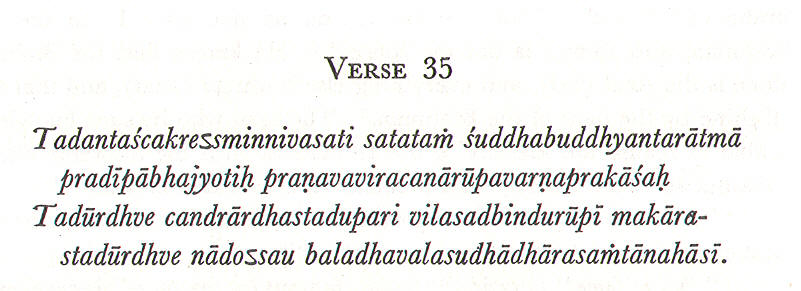
35. Tadantaścakreऽsminnivasati satataṁ śuddhabuddhyantarātmā
Pradīpābhajyotiḥ praṇavaviracanārūpavarnaprākaśah
Tadūrdve candrārdhastadupari vilasadbindurūpī makāra
stadūrdhve nādoऽsau baladhavalasudhādhārasaṁtanahāsī.
Within the triangle in this Cakra ever dwells the combination of letters which form the Pranava. It is the inner Atma as pure mind (Buddhi), and resembles a flame in its radiance. Above it is the half (crescent) moon, and above this, again, is Ma-kara, shining in its form of Bindu. Above this is Nada, whose whiteness equals that of Balarama and diffuses the rays of the Moon.
Swami Purnananda talks about Ajna Chakra from Verse 32 to 38.
letters = That is, a and u, which by Samdhi becomes 0, and with anusvara (m) thus form the Pranava, or mantra Om.
Ma-kara = The letter M in its Bindu form in Candra-bindu. .
Balarama = Samkara reads it as Jala-dhavala, etc., and explains it by "white like water". The last portion may also mean" smiling whiteness equals that of the Moon ".
The author desires to speak of the presence of the Pranava in the Ajna-Cakra and says that in this Cakra, and within the triangle which has already been spoken of, ever dwells the combination of the letters A and U which by the rules of Sandhi make the thirteenth vowel O. This combination of letters is Suddha-buddhyantaratma-i.e., the innermost Spirit manifesting as pure intelligence (Buddhi). The question may be asked if the thirteenth vowel (O) is that. To obviate this the author qualifies it by saying" above it is the half Moon, etc." It is by adding the half Moon (Nada) and Bindu to O that the Pranava is formed.
He next gives its attributes:
Pradipabhajyotih (Pradīpābhajyotiḥ ) = "Resembles a flame in its radiance? But how can this thirteenth vowel by itself be Suddha-buddhyantaratma ? He therefore says:
Tadurdve candrardhah (Tadūrdve candrārdha) = " Above it is the crescent moon" candrārdha = half-moon or crescent moon
tadupari vilasad-bindu-rupi ma-kara (tadupari vilasad-bindurūpī makāra)" And above this, again, is ma-kāra, shining in its form of Bindu" it is thus shown that by the placing of the crescent moon and the Bindu over the thirteenth vowel the Pranava is completely formed. Bindu = AnusvAra = After-sound when AUM is intonated. au is the 13th vowel and m is AnusvAra or the after-sound. AnusvAra is an m with a dot over or under it (eg. ṁ)
The here-depicted AUM/Om shows the dot. 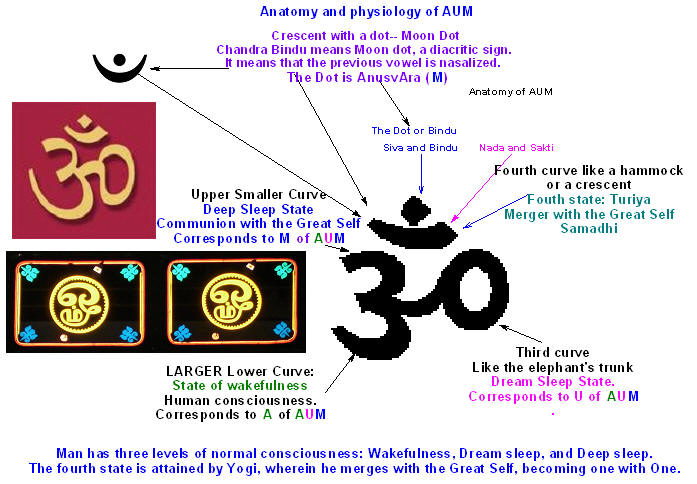
tadūrdhve nādo'sau-" Above this is Nada " i.e., above the Pranava is the Avantara (final or second) Nada, which challenges as it were the whiteness of Baladeva and the Moon (bala-dhavala-sudhā-dhāra-saṁthana-hāsī), By this he means to say that it is extremely white, excelling, in whiteness both Baladeva and the rays of the Moon (Visvanatha says, means multitude of moons).
Some read Tadadye nado'sau (in the place of Tadurdhve nado'sau) and interpret it as, "Below Bindu-rupi Ma-kara is Nada ". But that is incorrect. The text says: "Above this, again, is Ma-kara, shining in its form of Bindu," and there is Nada below it; that being so, it is useless to repeat that Nada is below.
Besides, this Nada is beyond the Nada, which forms part of the Pranava, and is part of the differentiating (Bhidyamana) Para-bindu placed above the Pranava, If, however, it be urged that it is necessary to state the details in describing the special Pranava (Visista-Pranava), and it is asked, "Why do you say a second Nada is inappropriate? " then the reading Tadadye nado'sau may be accepted.
But read. thus it should be interpreted in the manner following: " This Nada shown below the Bindu-rupi Ma-kara is Bala-dhavala-sudhadhara-samthana-hasi (v. ante), and the Nada first spoken of is also so described. Such repetition is free from blame on the authority of the maxim that" the great are subject to no limitations."

No comments:
Post a Comment